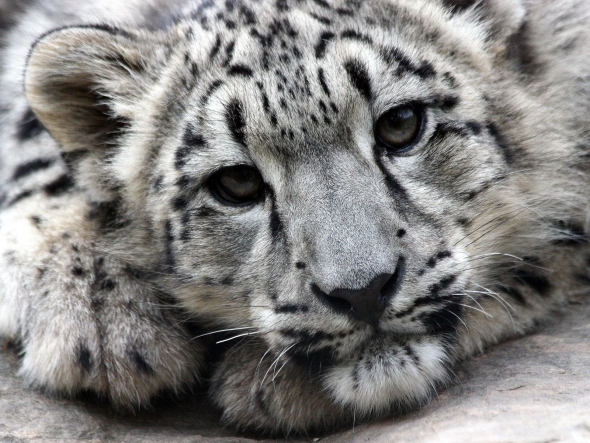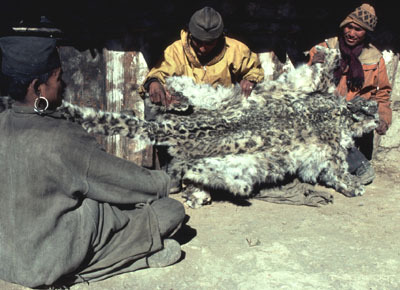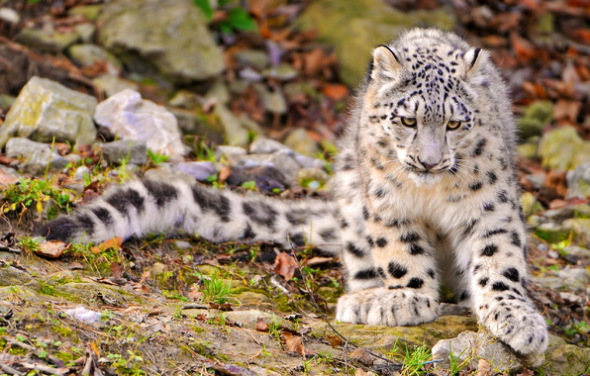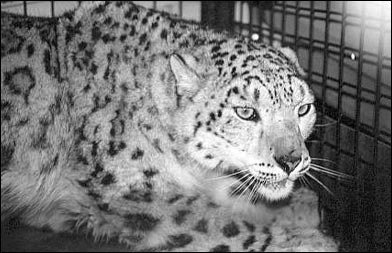Environmentalism Chapter 7 - Special Report - Snow Leopard

Located deep within the mountainous regions of Eastern Asia there lurks a shy predatory cat that’s so incredibly rare that locating this stunning this stunning magnificent mammal can take some days to even weeks or months in the snowy foot hills of Asia where their numbers are decreasing steadily.
With a population left of around 3,000 to 6,000 within the solitary wild and sadly listed on the International Union for the Conservation of Nature the Snow Leopard is now facing near extinction and we must all now help this species of large cat before the this magnificent mammal vanishes for good.
The highest populations of the Snow Leopard remain in China with roughly 3,000, and with regards to the other nations from Afghanistan, India, Bhutan, Kazakhstan, Kyrgyzstan, Mongolia, Nepal, Pakistan and Tajikistan, and Uzbekistan populations range from one hundred to five hundred of that.
The Snow Leopard Panthera uncia a member of the Lion and Tiger bag cat family was listed on the IUCN list of globally critically endangered species, and since then through to 2008 there has been very few sightings of prides of this relatively shy mammal that didn’t always live in the high tops of the snowy mountains of Asia.
Since 2008 there has been various wildlife and conservation expeditions showcasing this beautiful leopard however with illegal hunting and poaching rife within Asia then all numbered counts of the Panthera uncia are literally just estimated primarily due to them being very solitary mammals and due to the demand of poaching to feed the fur trade with illegally obtained skins and Traditional Medicine Market with counterfeit pharmaceuticals.
There are two subspecies of this “large wild feline” although it is not related to the domestic feline however the main species is Panthera uncial, and not Uncia uncial that live roughly at 4,000 to 6,000 feet in mountainous terrain well above sea level.
Weighing in at roughly thirty to sixty kilograms the Snow Leopard was first described by Schreber in 1775 that’s behaviour is very unique compared to other large Panthera families, only pairing during the breeding season they do not roar like Lions neither. Snow leopards are considered nocturnal, but seem to be most active in the early morning and late afternoon. They den in rocky caverns and crevices well hidden from destructive man that’s pushed contributed to them being pushed further up above sea level due to poaching and their natural habitat desolated from habitual destruction.
When the war in Afghanistan started there was an “estimated” one hundred to two hundred displaced many Snow Leopards killing some hundreds, since the war ended “still to be seen” there has been hardly a sighting, however they do still use the pass between Pakistan and Afghanistan to bed down, mate and create new bundles of fluffy snowy joy.
The snow leopard’s prey include wild sheep (such as Bharal, the blue sheep), wild boar, gazelles, hares, markhor, bobak, tahr, marmots, mice and deer. They stalk their prey and usually spring from a distance of 20 to 50 feet. The prey I have listed above in the regions of which they have been estimated as high in numbers are becoming small in population to due to the medicine market, and because their “natural habitat” is becoming rapidly wiped out due to agriculture, over grazing, and vast massive population increase that leads to vast urbanisation and hunting too of which their forced higher up into the hills to look for prey or they simply perish.
The Snow Leopard has adapted though remarkably well to these conditions that are mainly icy and snowy they discreetly hide within rock caves and crevices thus making it much harder for the poacher to locate them.
Breeding season is usually January-May, with gestation lasting 98-103 days. A female will give birth to one to four young in the spring in a rocky shelter lined with her fur. The young open their eyes at 7-9 days, eat solid food at 2 months and follow their mother on hunts at three months. Cubs remain with the mother through their first winter.
Females give birth in rocky dens lined with their fur. The young follow their mother on hunts at three months and remain with her through their first winter.
Several forces are responsible for the low numbers of snow leopards left in the wild which I have described in brief below. The cats have thick, rosette-speckled fur that makes them the unfortunate target of poachers who sell their pelts in illegal markets in China, Taiwan, and Mongolia.
The furs of the endangered cat command high prices on black markets. During the 1960s, poaching drove populations as low as 1000 individuals. Although numbers of snow leopards have recovered somewhat in recent decades, there remains concern about illegal poaching as numbers of the cat in the wild are believed to be again falling. There is also demand in China for snow leopard bones for use in traditional medicines (Cat Specialist Group, 2002).

Snow Leopard pelts can fetch between $1,000 to $5,000 with most funds going to armed terrorism fractions.
Snow leopards also face the grim threat of a declining prey supply. Widespread poisoning of marmots and pikas across the Tibetan Plateau coupled with extensive hunting of large ungulates have left the leopard population without the food supply it needs. Some leopards turn to the taking of livestock animals when faced with dwindling wild food sources.
March 2012 a news report quoted “Leopards which live in increasingly fragmented populations in Asia, are protected under Appendix I of the Convention on International Trade in Endangered Species of Wild Fauna and Flora along with those in Africa too, which completely prohibits commercial trade in the animals or their body parts”
“But as is the case with tigers and other species, poaching and illegal trade along with other factors such as habitat loss places enormous pressure on leopards. All nine of the world’s leopard subspecies are listed as “Near Threatened” by the International Union for Conservation of Nature and Natural Resources due to declining populations.
Snow leopards, which are endangered, are a separate species however are not in realty obtaining the same attention as the other remaining leopards in India which we all now need to start creating massive awareness on.
August 2012 an article in the Asian times also stated that rangers and farmers were also placing these beautiful cats in severe endangerment http://prizmablog.com/2012/08/02/rangers-poacher-decimate-snow-leopards-but-kumtor-mine-gets-ngos-attention/ if we cannot trust our rangers to farmers then what chance of life does the Snow Leopard stand.
“When you play this video it sounds more like a cheap porn version of desperate Russian Housewives, however you need to look very carefully at the description. With the aid of our bilingual investigators we are able to locate these sick individuals. Within the their VIDEO they freely advertise on the description below “Tiger Skins” and anything your heart desires. It is a criminal offence under CITES and IUCN law to slaughter, hunt, poach, trade and distribute to selling of TIGER or Leopard skins as they freely advertise on the World Wide Web. Who’s it left down to though to shut these traders down? ourselves that we have been doing now since 2009. Heat breaking to view but watched with anger. CITES and the IUCN should be closing these traders down and making arrests yet they are still here in Russia”..
Their website can be located here - http://www.roskoshmexa.ru/dost/index.htm
Their detail’s that are now in the hands of Law Enforcement - as we can see they have concealed their illegal money making business quite well “to a degree” but not to our investigative team CICU http://www.ip-adress.com/whois/roskoshmexa.ru
YouTube channel here which is somewhat nauseating
http://www.youtube.com/user/roskoshmexa/videosview=0&flow=grid
28th September 2012 confirmed what we already were aware of with regards to the fur trade and this is where my blood boils badly. Celebrities that know damn well how these animals are treated to even wearing the animal skins themselves are completely oblivious to the environmental destruction that they are causing. The infamous blood skin wearers as I call them may not always be “wearing critically endangered animals” however they are aiding to the bloody demand as their “supporters” wish to follow in their footsteps, being mainly children and teenagers to young mothers and fathers.
Lady Gaga, Kate Moss, Giorgio Armani, Kourtney Kardashian, Scott Disick and their son Mason (all wearing fur) Popstar Rihanna, Chloe Green, television personality, shoe designer and daughter of Top Shop owner Sir Phillip Green wears fur without the care in the damn world of what they are causing, and Hyomin, member of South Korean pop group T-ara wearing dead skinned animals that have been electrocuted or gassed or skinned alive as it “makes the fur more subtle.
(how charming and sweet) what about the skinned animals, the caged waiting to be skinned losing control of their bowls as they hear the cries of their caged species tortured, with their lifeless bodies thrown on to a dump of still moving dying carcasses to “keep up with demand”.
A report issued by the International Union for Conservation of Nature stated that India has only 1,700 Leopard species left, out of them species is the Snow Leopard the most sought after as of its fur colour plus price tag that can range from $6,000 to $30,000 a skin. With the Leopard at now near threatened and with more Tiger species then we can most certainly say that they will be the first pushed to extinction within the next year to two years if that.
Statistical analysis is used to estimate the additional levels of “undetected trade” and concludes that around 2294 Leopards were trafficked in India during the period—an average of four animals per week over the 10 year period.
TRAFFIC’s objective analysis has cast new light onto the sheer scale of the illicit trade in Leopard parts in India, which has hitherto been overshadowed by the trade in another of the country’s national icons, the Tiger.
Without an effective strategy to assess and tackle the threats posed by illegal trade, the danger is that Leopard numbers may decline rapidly as happened previously to the Tiger.

Uttarakhand emerged as a major source of Leopard parts in trade, while Delhi was found to be a major epicentre of the illegal trade, along with adjacent areas of Uttar Pradesh, Himachal Pradesh and Haryana.
Close to 90% of reported Leopard part seizures in India comprised solely of skins, making them the dominant body part found in illegal trade during the 10 year period. Other body parts, particularly bones, are known to be prescribed as substitutes for Tiger parts in traditional Asian medicine including Lions Panthera leo.
It is believed most Leopard parts are smuggled out of India to other countries in Asia, often via the porous border with neighbouring Nepal. Earlier investigations indicated many of the Leopard parts found for sale in northern Myanmar, northern Laos and the ethnic Tibetan regions of China originated from India.
However with such poaching epidemics the snow leopard face’s other threats so as quoted above. Panthera uncia hunts on rich alpine lands, however their prey bharal or blue sheep (Pseudois nayaur) and ibex (Capra sibirica) whose distribution coincides closely with snow leopard range plus the marmot (Marmota spp), pika (Ochotona spp.), hares (Lepus spp.), small rodents, and game birds also feed of these areas lower down the mountainous ridges.
As of natural habitual loss of the Snow Leopards prey’s food consumption being mainly alpines, scrubland, insects and green pastures from “over grazing”, climate change, longer winters, and agriculture then this see’s the prey that the farmers allow up to these areas then move on to fresh pastures, thus displacing the Snow Leopard’s prey = starvation for the adult and cubs..
The IUCN reported “A major threat to the Snow Leopard include prey base depletion, conflict with local people, and lack of conservation capacity, policy and awareness.
Within the Himalayan region (Tibetan Plateau and other southern China, India, Nepal and Bhutan) reduction of natural prey due to competition with livestock, killing of snow leopards in retribution for livestock depredation, lack of trans-boundary cooperation, military activity, and human population growth or poverty.
Within the regions of Northern range (Russia, Mongolia, and Altai and Tien Shan ranges of China) poaching snow leopards for trade in hides or bones, lack of appropriate policy and effective enforcement, lack of institutional capacity and awareness among local people and policy makers, and human population growth or poverty.
Although Snow Leopards are killed in retribution for livestock depredation, they are also killed for commercial purposes, and poaching for illegal trade does represent “a significant threat”. Pelts appear to be the main snow leopard produce in demand, but there is also evidence of demand for live animals for zoos and circuses which is VERY CONCERNING. Other body parts found in trade include bones (used especially in Chinese medicine as a substitute for tiger bone), as well as claws, meat and sexual organs of male cats.

Snow Leopard sized in a Circus Kyrgyzstan in central Asia (Critically Endangered)
Then the real news starts to emerge that we didn’t expect to hear although we knew as other conservationist’s did the United States Army are fueling the demand for endangered species without even realising that they are actually supporting more terrorism through black market sales. This is alarming and extremely concerning that’s now being addressed but to what degree we still don’t know.
A report stated by the Eco-centric wildlife press of which I have placed the extract below I have also included the link for February 27th 2012. The link is worrying as this could now give reason to believe why there are so many “endangered species part products in America and Canada”. The report reads; http://science.time.com/2012/02/27/wildlife-wars-how-u-s-soldiers-unknowingly-support-the-endangered-species-trade/
You’re a U.S. soldier, abroad on your first deployment in Afghanistan. Like any world traveler you want to bring a souvenir back home to the family, something they could never get at home. So you visit the local market on base, where Afghan vendors sell carpets, trinkets and clothing. And you pick out something really cool: a white spotted pelt, perfect for a rug. What could possibly be wrong with that purchase?
As it turns out, quite a lot—at least for endangered species. According to a study from the Wildlife Conservation Society (WCS)—an environmental non-profit that runs the Bronx Zoo in New York—a significant number of U.S. soldiers deployed overseas have purchased products made from wildlife. And in many cases, that wildlife is threatened—like the endangered snow leopard of Central Asia, which could have been killed to make that fine white pelt. Most soldiers aren’t knowingly purchasing products made from endangered species, but they are inadvertently supporting that trade, which can have serious consequences for conservation. “The wildlife trade is highly problematic,” says Heidi Kretser, the coordinator of the WCS North America Programs Livelihood. “There needs to be awareness raising in the military.”
The WCS research began back in 2007 when staff in Afghanistan noticed products made from threatened species being sold on military bases near Kabul. That led to a survey of nearly 400 soldiers at Fort Drum in upstate New York, one of the biggest military bases in the U.S., sending some 80,000 troops a year to Iraq and Afghanistan during the height of the conflicts.
WCS found that more than 40% of the soldiers surveyed had either purchased wildlife products or had seen a fellow service member buy one. They reported seeing wildlife items for sale on or off bases in 40 countries, with the greatest number by far in Afghanistan—a fact that makes sense, given that the Central Asian country is home to a number of endangered species, including the snow leopard. (The sheer number of U.S. troops stationed in Afghanistan played a role in the numbers as well.) “The most popular items were fur coat and rugs,” says Kretser. “And there you’re talking about species that do tend to be threatened.”
The problem isn’t just that U.S. service members are buying wildlife products—it’s that their presence in countries like Afghanistan and Iraq helps create a market for poaching and hunting that might otherwise not exist.
American soldiers—and even more so, the contractors and other international personnel who follow in their wake—can bring developed world purchasing power to bear in a developing world. Suddenly an Afghan who might have no one to sell that snow leopard pelt to—and therefore, no reason to participate in the trade in the first place—suddenly has a ready market with well-off customers. “You can sell a snow leopard pelt for $1000,” says Kretser. “That’s far more than the average Afghan person could make in a year.”
You can’t blame a poor person for trying to earn that kind of money—which is why it falls to the customers more than anyone else to halt the wildlife trade. There are international and military regulations that prohibit the purchase and transport of products made from endangered wildlife, That’s why Krester and the WCS have been working with the Department of Defense’s Legacy Program on educational courses for personnel who are about to be deployed overseas.
The programs underscore the illegality of purchasing endangered wildlife products, as well as the potential health threats that can come with them. (Wildlife—especially primates—are a major source of zoonotic disease, and the international trade can spread those diseases around the world.) The hope is that by educating service members early, they’ll be that much less likely to pick up a wildlife souvenir to take home with them.
This year 2013 Hilary Clinton then announced in a media report that the United States was the “SECOND” LARGEST importers of illegal wildlife products in the world to-date. More concerning is the money earned from the illegal trade of living animals and dead animal parts is roughly equal to that of illegal weapons smuggling and second only to drugs as an illegal business.
Organized crime is thought to be involved in the trade of ivory, coral, snake skins, conch shells, shahtoosh and abalone. Many smugglers who made a living in gold and narcotics now are into wildlife trading. Among the attractions are the light sentences if you get caught and the low probability of getting caught because of the low priority given to wildlife crimes by authorities.
The Internet has been a boon for the exotic animal traders and detriment to threatened species. Among the animals and animal products available on the web are young giraffes for $15,000, a black leopard for $4,000 gorilla for $8,131, baby chimpanzees for $60,000, cotton-top tamarins for $2,500, hawksbill turtle shells for $120, elephant bone sculptures for $18,000, crocodile skin boots, seahorse skeletons, ivory sculptures, and shahtoosh shawls.
Only yesterday 20th January 2013 my investigations team the CICU located our 7th illegal trader selling and distributing “Siberian Tiger skins” and bones, please view the link here - http://myworld.ebay.ca/reptilesmorpho/?_trksid=p4340.l2559 we then located his site here http://www.cougarsdentaxidermy.com/#! On locating more we then found that the Siberian Tiger that is only numbered as 500 maximum in the wild is listed for sale via two rug skins “both sold to two American’s” http://www.cougarsdentaxidermy.com/#!stuff-for-sale/vstc1=rugs-for-sale/productsstackergallery4g5=1
With the illegal animal parts trade being worth or more or less the same as the illegal market in arms and narcotics one can clearly see that it’s not just the Asian poachers to blame here its everyone that wants a piece of gold which is more easier to obtain and to ship thus making big bucks via slaughtering wanted endangered mammals and reptilians to aquatics.
With the American military purchasing endangered and critically endangered parts then the war on terrorism is in reality being “funded to a degree” by themselves without them knowing it.
The Snow leopard is in big danger of extinction within the next year to two years, and should no species recovery be achieved to slow this trade to even cease it that is not just being used for rugs, medicine and cultural beliefs but also mainly now for terrorism then we will view the Snow Leopard gone with many other species of species too.
To be continued …
Dr J C Dimetri V.M.D, B.E.S, Ma, PhD, MEnvSc
One may believe that WWW do not the rescue, well your correct. The WWF is not a rescue that are a “wild animal unit” that specializes in “WILD ANIMALS” they don’t rescue canines, felines, zoo animal’s, the don’t deal with domestic abuse. They are an environmental organisation that works to save “WILD ANIMALS” hence the name World Wildlife Fund. They are well known for their pioneering work to save and protect iconic wildlife like pandas, tigers, whales and rhinos - and have had some great achievements in those areas since we started in 1961.
THE ILLEGAL WILDLIFE TRADE STOPS HERE - PLEASE REPORT ANY CONSERVATION CRIME YOU WITNESS OR LOCATE TO US AS THE ADDRESS BELOW - OR CONTACT YOUR LOCAL INVESTIGATIONS / CUSTOMS UNIT
[email protected] Conservation Investigations Crime Unit C.I.C.U.
WARNING
You are breaking the law if you poach, illegally hunt, sell, distribute, purchase or smuggle any CITES or IUCN prohibited animal contraband. Should we locate/know off/ you breaking this law you will be punished with a maximum prison sentence of up to life imprison -
All information that we obtain from ground to online we share with third parties too.. Don’t be a fool and put the gun down.



